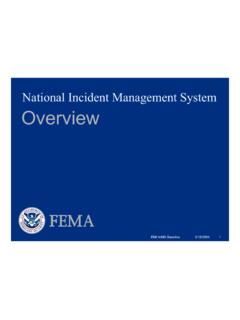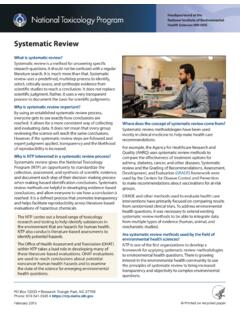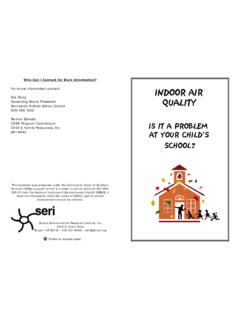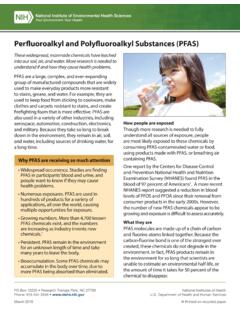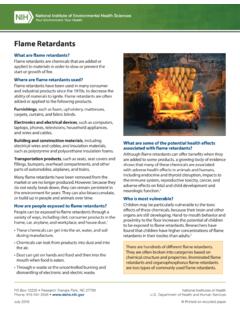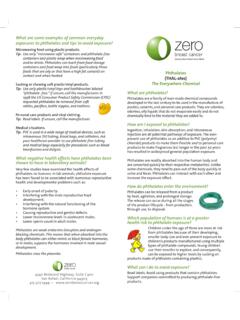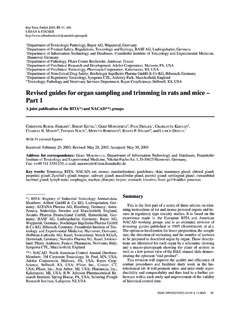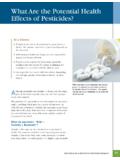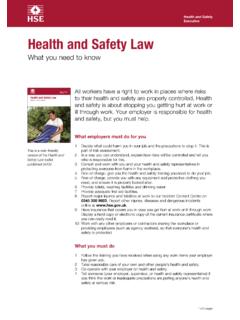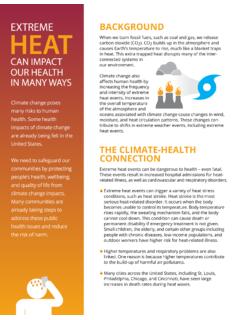Transcription of Environmental Diseases: Environmental Diseases From A to …
1 The AIR, the WATER, the SUN, the DUST, PLANTS and ANIMALS, and the CHEMICALS and METALS of our support life. They make it beautiful and , as wonderful as they can also make some people sick. Here are some Diseases that are related to yourAllergies and Asthma (AZ-ma)Slightly more than half of the 300 million people living in the are sensitive to one or more allergens.* They sneeze, their noses run and their eyes itch from pollen, dust and other substances. Some suffer sudden attacks that leave them breathless and gasping for air. This is allergic asthma. Asthma attacks often occur after periods of heavy exercise or during sudden changes in the weather. Some can be triggered by pollutants and other chemicals in the air and in the home. Doctors can test to find out which substances are causing reactions. They can also prescribe drugs to relieve the symptoms.*Prevalences of Positive Skin Test Responses to 10 Common Allergens in the Population: Results from the Third National Health and Nutrition Examination Survey Jour.
2 Allergy Clinical Immunol. August DefectsSometimes, when pregnant women are exposed to chemicals or drink a lot of alcohol, harmful substances reach the fetus. Some of these babies are born with an organ, tissue or body part that has not developed in a normal way. Aspirin and cigarette smoking can also cause birth problems. Birth defects are the leading cause of death for infants during the first year of life. * Many of these could be prevented.*National Institute of Child Health and Human occurs when a cell or group of cells begins to multiply more rapidly than normal. As the cancer cells spread, they affect nearby organs and tissues in the body. Eventually, the organs are not able to perform their normal functions. Cancer is the second leading cause of death in the , causing more than 500,000 deaths each year.* Some cancers are caused by substances in the environment: cigarette smoke, asbestos, radiation, natural and man-made chemicals, alcohol, and sunlight. People can reduce their risk of getting cancer by limiting their exposure to these harmful agents.
3 *Centers for disease Control and Prevention Office of Minority some ideas for preventing or caring for them. Fertility ProblemsFertility is the ability to produce children. However, one in eight couples has a problem. However, more than 10 percent of couples cannot conceive after one year of trying to become pregnant.* Infertility can be caused by infections that come from sexual Diseases or from exposure to chemicals on the job or elsewhere in the environment. Researchers at The National Institute of Environmental Health Sciences (NIEHS) have shown that too much caffeine in the diet can temporarily reduce a woman s fertility. NIEHS scientists have also pinpointed the days when a woman is likely to be fertile.*National Library of Medicine s Medline Plus. Goiter (GOY-ter)Sometimes people don t get enough iodine from the foods they eat. This can cause a small gland called the thyroid to grow larger. The thyroid can become so large that it looks like a baseball sticking out of the front of your neck.
4 This is called goiter. Since the thyroid controls basic functions like growth and energy, goiter can produce a wide range of effects. Some goiter patients are unusually restless and nervous. Others tend to be sluggish and lethargic. Goiter became rare after public health officials decided that iodine should be added to (durmuhTIE-tiss)Emphysema (EM-fuh-ZEE-ma)Air pollution and cigarette smoke can break down sensitive tissue in the lungs. Once this happens, the lungs cannot expand and contract properly. This condition is emphysema. About 2 million Americans have this disease . For these people, each breath is hard work. Even moderate exercise is difficult. Some emphysema patients must breathe from tanks of is a fancy name for inflamed, irritated skin. Many of us have experienced the oozing bumps and itching caused by poison ivy, oak and sumac. Some chemicals found in paints, dyes, cosmetics and detergents can also cause rashes and blisters. Too much wind and sun make the skin dry and chapped.
5 Fabrics, foods, and certain medications can cause unusual reactions in some individuals. People can protect themselves from poison ivy by following a simple rule: Leaves of three, leave them be. Smart folks know their IllnessesEvery job has certain hazards. Even a writer can get a paper cut. But did you know that about 137 workers die from job-related Diseases every day? This is more than eight times the number people of who die from job-related accidents. Many of these illnesses are caused by chemicals and other agents present in the workplace. Factories and scientific laboratories can contain poisonous chemicals, dyes and metals. Doctors and other health workers have to work with radiation. People who work in airports or play in rock concerts can suffer hearing loss from loud noise. Some jobs involve extreme heat or cold. Workers can protect themselves from hazards by wearing special suits and using goggles, gloves, ear plugs, and other DiseaseHeart disease is the leading cause of death in the United States and is a major cause of disability.
6 Almost 700,000 Americans die of heart disease each year.* While these may be due in part to poor eating habits and/or lack of excercise, Environmental chemicals also play a role. While most chemicals that enter the body are broken down into harmless substances by the liver, some are converted into particles called free radicals that can react with proteins in the blood to form fatty deposits called plaques, which can clog blood vessels. A blockage can cut off the flow of blood to the heart, causing a heart attack.*Centers for disease Control and Deficiency Diseases The immune system fights germs, viruses and poisons that attack the body. It is composed of white blood cells and other warrior cells. When a foreign particle enters the body, these cells surround and destroy this enemy. We have all heard of AIDS and the harm it does to the immune system. Some chemicals and drugs can also weaken the immune system by damaging its specialized cells.
7 When this occurs, the body is more vulnerable to Diseases and infections. Kidney DiseasesAbout million adults have some evidence of chronic kidney disease .* These Diseases range from simple infections to total kidney failure. People with kidney failure cannot remove wastes and poisons from their blood. They depend on expensive kidney machines in order to stay alive. Some chemicals found in the environment can produce kidney damage. Some nonprescription drugs, when taken too often, can also cause kidney problems. Be sure to read the label and use drugs as directed.*National Kidney and Urologic Diseases Information System DisordersThe nervous system, which includes the brain, spinal cord and nerves, commands and controls our thoughts, feelings, movements, and behavior. The nervous system consists of billions of nerve cells. They carry messages and instructions from the brain and spinal cord to other parts of the body. When these cells are damaged by toxic chemicals, injury or disease , this information system breaks down.
8 This can result in disorders ranging from mood changes and memory loss to blindness, paralysis and death. Proper use of safety devices such as seat belts, child restraints and bike helmets can prevent injuries and save PoisoningSometimes, infants and children will pick up and eat paint chips and other objects that contain lead. Lead dust, fumes and lead-contaminated water can also introduce lead into the body. Lead can damage the brain, kidneys, liver, and other organs. Severe lead poisoning can produce headaches, cramps, convulsions, and even death. Even small amounts can cause learning problems and changes in behavior. Doctors can test for lead in the blood and recommend ways to reduce further PoisoningMercury is a silvery metal that is extremely poisonous. Very small amounts can damage the kidneys, liver and brain. Years ago, workers in hat factories were poisoned by breathing the fumes from mercury used to shape the hats. Remember the Mad Hatter in Alice in Wonderland?
9 Today, mercury exposure usually results from eating contaminated fish and other foods that contain small amounts of mercury compounds. Since the body cannot get rid of mercury, it gradually builds up inside the tissues. If it is not treated, mercury poisoning can eventually cause pain, numbness, weak muscles, loss of vision, paralysis and even death. Osteoporosis (OSS-tee-oh-por-OH-sis)Over 10 million Americans have osteoporosis, while 18 million others have lost bone mass and are likely to develop osteoporosis in the future.* This is called osteoporosis. About 25 million Americans suffer from some kind of bone thinning. As people get older, back problems become more common, and bones in the spine, hip and wrists break more easily. Young people can lower their chances of getting osteoporosis in later years by exercising and eating calcium-rich foods like milk and yogurt.*Harvard Center for Cancer FeverPeople do not usually get Diseases from farm animals. However, those who work with hides and animal products can get sick from breathing the infected dust around them.
10 This illness is called Queensland fever because it was first discovered among cattle ranchers and dairy farmers in Queensland, Australia. It is caused by a tiny organism that infects livestock and then spreads to the milk and feces. Symptoms include fever, chills, and muscle aches and pains. Researchers have developed vaccines to protect livestock workers from this DisordersBeginning in the late 1940 s, many women who were in danger of losing their unborn babies were prescribed a synthetic female hormone called DES (diethylstilbestrol). In 1971, scientists discovered that some of the daughters of these women were developing a very rare cancer of the reproductive organs. Since then, the use of DES and other synthetic hormones during pregnancy has been discontinued. NIEHS and other agencies are studying the possibility that some natural chemicals and man-made pesticides may cause similar problems. They are finding that some of these chemicals are so similar to female estrogen that they may actually mimic this important hormone.
